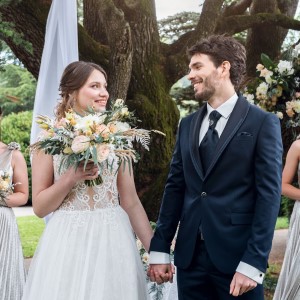The 3 Reasons Where and How You Stand during Your Wedding Ceremony is Important
/08
by Jennifer
Cram - Brisbane Marriage Celebrant © (23/08/2022)
Categories: | Celebrant | Wedding Ceremony | Wedding Legals
 How and where
the two of you, and your celebrant, stand during
your wedding ceremony impacts on photographs of the
ceremony and how easy it is for your photographer to
capture those iconic moments.
How and where
the two of you, and your celebrant, stand during
your wedding ceremony impacts on photographs of the
ceremony and how easy it is for your photographer to
capture those iconic moments. Photos are important. But strangely enough, it is still widely accepted that wedding choreography should happen in the way it did before cameras were invented.
Like most other things with weddings there are historical reasons for how and where the marrying couple and their celebrant (or the clergyperson) stand during the wedding ceremony. These may longer apply but are nonetheless still preserved as "traditions".
There are also other things to take into account, including the legalities.
The Religious
Tradition - how it all started
In the 21st century, where
and how you stand impacts on three important
things:
1. How and where
you stand impacts on being heard
2. How and
where you stand impacts on the
Photographs
3. How and where you
stand is important for your Marriage
How and Where You Stand and Why that is Important for your Marriage.
How and where the marrying couple stands during the ceremony impacts on photographs of the ceremony. But it can also have far-reaching impact on the marriage and on how much support the couple (as opposed to each individually) receives during the marriage thanks to the magic of imprinting.
Imprinting is a special type of learning that is very different from regular learning. It is irreversible. And it takes place generally in very restricted and brief stages in development.
I first came across the notion of imprinting the image of the bride and groom as a couple on the minds of their community of family and friends at a traditional African wedding I attended at a child.
At one point the couple just sat side by side for a long period of time and nothing was happening, or so it seemed to my eight-year-old mind. So I started to fidget. Only to be told to sit quietly because we must all look at the couple and recognise that they are married.
Then, as an undergraduate student I was introduced to the work of Konrad Lorenz in first year psychology. By observing newly hatched ducklings and goslings, Lorenz realised the importance of social bonding, and that to recognise adult members of its own species the young bird requires this special type of learning.
And what does this have to do with how and where the bride and groom (or two brides or two grooms) stand?
Think about it. At the majority of civil celebrant weddings the celebrant stands slap bang in the middle throughout the ceremony (photographers hate that too!) with the couple standing in front of the celebrant either holding hands or facing one another but some distance apart (I call that facing off and it always makes me think of a boxing ring just before the fight commences).
So what is the picture the guests are imprinting? A threesome!
While, in a religious wedding, the positioning of the clergyperson between, and usual slightly above, the couple, is symbolic of the expectation that religious belief and the deity will be ever present in their marriage, unfortunately (for your secular marriage) most celebrants also love that set up. Some even describe the couple standing side by side, facing their guests, as "awkward".
Really? A couple, clearly in love, dressed in the finery that emphasises the importance of the step they are taking, standing side by side holding hands and facing family and friends as their relationship is celebrated is anything but awkward. It is a powerful image of intimate unity.
And it is that image that guests should take away with them, imprinted firmly and irreversibly on each and every mind.
Where do I stand?
- Before the ceremony starts I will stand
in the middle to introduce myself and make
housekeeping announcements and then move to one
side
- For the first part of the ceremony I
stand to one side where I can easily look at
your guests when I'm talking to them, and at you
when I'm talking to you, and no-one will need to
do an extreme neck-swivel or have creases in the
side of their neck
- When we get to the legal bits (your vows) I may move in closer to you, but, even if I'm holding the microphone for you, I tuck myself behind your shoulder to make it easy for your guests to focus on you, and for your photographer to capture the expressions on your faces
- For your exchange of rings and the pronouncement, I'm out of there, back off to the side, so you don't get any celebrant body parts in your photos
- For your kiss. I'm nowhere to be seen!
- For the signing. I point out where you need to
sign and then take a step back to make it easy
for your photographer to capture the moment
without your celebrant photobombing the moment.
- For your walk back up the aisle. Still
out of the picture. And definitely not moving
around or packing up
Where and how
should you stand
- For the first part of the ceremony, standing side by side, facing your guests, and holding hands the way you do when you are walking down the street
- For your vows, turn to face one another. Whether you plan to read your vows or repeat them after me will impact on how you hold hands
- For the pronouncement, back facing your guests (and looking at me!)
- For the kiss - Go for it!
Or you can sit
If you are more comfortable getting married while
seated, of course you can!
Selfies?
I'm not going to be expecting you to leave your
guests for even a moment to take a selfie with me.
But if you would like to take a selfie with me, or
have your photographer take an informal shot or
two of us together, happy to oblige.
This article is an updated and expanded
rewrite of an earlier post The
Psychology of Weddings: How and Where You
Stand published 20/07/2016
Did
you enjoy reading this post? Let's talk
about how we can make your dream wedding a
reality.

pullin0 Things